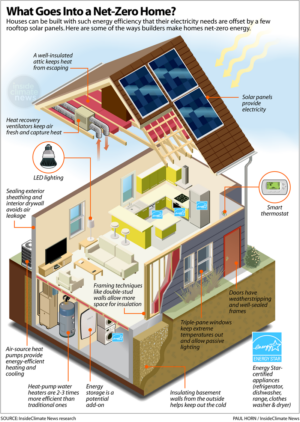Energy-conscious retrofits can dramatically reduce the carbon footprint of housing without the need to start from scratch
January 7, 2020 —  With the world in an unprecedented climate crisis, many of us wonder what we can do as individuals to reduce our carbon footprint. A significant step could begin at home.
With the world in an unprecedented climate crisis, many of us wonder what we can do as individuals to reduce our carbon footprint. A significant step could begin at home.
In Canada, housing and other buildings account for up to 17% of the country’s greenhouse gas emissions. Globally, “operational emissions” — emissions from the energy used to heat, cool, light and operate buildings — accounts for 28% of global carbon emissions.
One way to reduce this is to make homes “net zero” energy — able to produce as much energy as they consume thanks to solar panels, heat pumps, a super-tight barrier between the inside and outside, above-code insulation, and energy-efficient windows, lighting and appliances.
New homes can be built to such specifications. But even better from a climate perspective, according to the World Green Building Council (WorldGBC) — a network of national green building councils in some 70 countries worldwide — is to renovate existing homes. That’s because renovation reduces the need for new building materials, which require energy to produce, transport and install in the first place.
Energy Upgrades
 Toronto-area engineer and net zero housing expert Michael Lio, president of buildABILITY, identifies upgrades to exterior elements of the home, such as windows and insulation, as primary ways to affordably move toward net zero energy.
Toronto-area engineer and net zero housing expert Michael Lio, president of buildABILITY, identifies upgrades to exterior elements of the home, such as windows and insulation, as primary ways to affordably move toward net zero energy.
Lio says that how your utility produces electricity is a big factor in achieving net zero in a renovation. “In the province of Ontario, where I live and work, our electricity grid is 94% carbon-free, so it’s easy to get to [net zero]. You just switch from gas to electric and install a cold climate air-source heat pump to heat and cool your home,” he says.
What about achieving net zero energy renovation in a region where electricity comes from fossil fuels? That is one of the challenges facing net zero renovator Peter Darlington of Solar Homes Inc. in Calgary, Alberta, where most electricity comes from natural gas.
“Because our grid is dirty, our eventual goal for a net zero [energy renovation] is to disconnect from fossil fuels altogether and self-generate renewable energy,” says Darlington.
In 2015, Darlington transformed his ordinary house into a net zero energy home by including solar panels and reducing the amount of energy his home consumed through increased insulation, airtightness, high-performance windows, and energy-efficient lighting and appliances. Over the next year, Darlington’s solar panels produced more energy than his house consumed, which he says prevented 13 metric tons (14 tons) of carbon dioxide from entering the atmosphere.
Darlington’s strategy with net zero renovations for clients is to seal and insulate the home’s exterior walls to reduce heat loss. He removes the existing siding, applies a liquid sealing compound, then insulates with expanded polystyrene, a product he says has minimal “embodied carbon” — emissions associated with building materials and construction throughout a building’s entire life cycle — and very little waste and is 100% recyclable.
Once the exterior walls have been sealed and insulated, Darlington encourages his clients to proceed with their net zero renovation in stages, minimizing waste and cost along the way by using existing elements of the home, such as windows and ductwork, where possible.
“The sweet spot for renovating to net zero is someone who is already planning a home renovation,” says Darlington. In some cases the cost of the net zero elements can be partly offset by government rebates for energy-efficient windows and solar energy systems. Energy savings — up to 90% for a complete net zero renovation including solar panels — can add up to another CA$5,000 per year.
“There are lots of people spending [CA]$50,000 or more on cosmetic upgrades to their homes. Why not spend a little more? A net zero upgrade will save you money — and help the environment — every year for the rest of your life,” he says.
Embodied Carbon
A recently released report from WorldGBC identified that “embodied carbon” in building and construction is responsible for 11% of all human-generated carbon emissions in the world.
That means that that net zero renovations can be more climate friendly than new construction because they use many existing materials.
“The most sustainable buildings may be the ones that exist,” says Victoria Burrows, director of advancing net zero for WorldGBC. “We promote net zero renovations over building new homes because the opportunities are there to control embodied carbon, such as reducing raw materials.” Such efforts can move a home beyond net zero energy toward also compensating for greenhouse gas emissions associated with materials and construction.
Architecture 2030, a nonprofit organization with a mission to reduce greenhouse gas emissions of the built environment, is a lead partner in the WorldGBC’s Advancing Net Zero project. The organization notes that architects, engineers, builders and renovators can check with building product manufacturers to identify and source products with little if any embodied carbon — the rationale being that those that are conscious of their embodied carbon will freely divulge this information. It also provides embodied carbon design and planning tools for doing so, such as an EPD (Environmental Product Declaration) Quicksheet and a Carbon Smart Materials Palette.
For renovations, this can mean choosing materials with small carbon footprints and finding new uses for materials removed during the fix-up.
“Blown cellulose is the best insulation because it comes from trees, a renewable and carbon-neutral resource, and takes little energy to produce,” says net zero housing expert Lio. “And, when replacing windows during a renovation, the old ones can be dismantled and recycled to make insulation.”
Next Best Thing
Net zero may make sense for anyone planning to renovate their home. But what about homeowners who can’t afford a full renovation?
Those on a tighter budget could have an energy audit to identify energy-saving opportunities with a payback in energy savings that fits their circumstances. In some cases local utilities cover part or all of the audit fee, help with financing, or offer rebates on insulation, new windows and heating equipment.
“Ultimately, the goal of lowering our carbon footprint at home is to reduce our energy consumption while taking embodied carbon into consideration. This involves improving energy efficiency, reducing our dependence on fossil fuels, and switching to renewables where possible,” says Lio. “How you do it depends on how much you’re willing or able to invest in a home renovation. Every little bit helps.”
UPDATED 01.15.20: The credit for the before-and-after renovation and image was corrected.
Originally published
by Ensia
January 7, 2020





